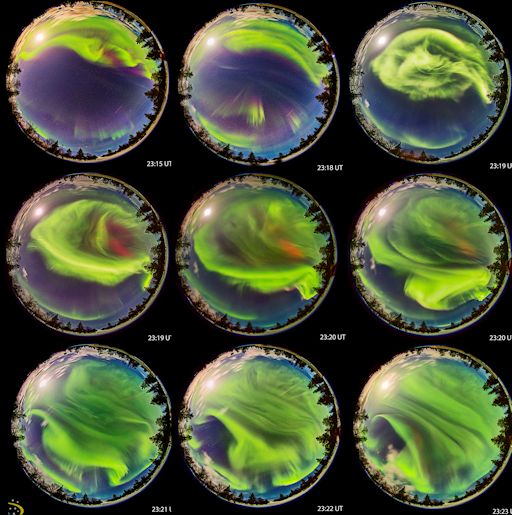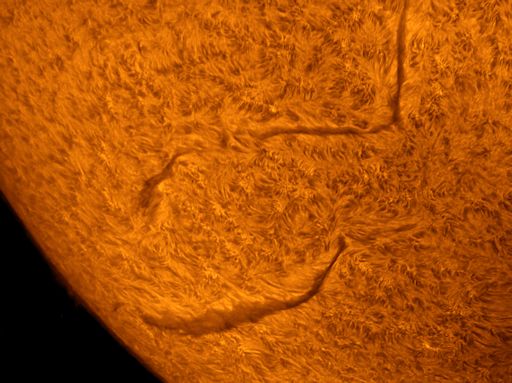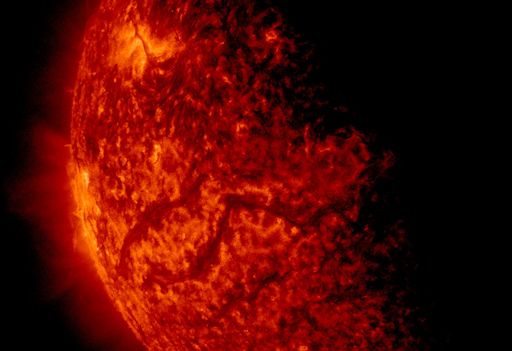When is the best time to see auroras? Where is the best place to go? And how do you photograph them? These questions and more are answered in a new book, Northern Lights - a Guide, by Pal Brekke & Fredrik Broms. | | |
MOTHER'S DAY AT THE EDGE OF SPACE: Looking for a unique gift for mom? How about an Edge of Space Mother's Day Card? On March 16th, the students of Earth to Sky Calculus will launch a helium balloon to the stratosphere. For only $49.95, your mother's day, father's day, birthday or anniversary card could be on the payload. Profits from the flight are used to support the students' space weather balloon research program. Contact Dr. Tony Phillips for details.
AURORA STORM: On March 12th, an unexpected geomagnetic storm erupted around the Arctic Circle. The G1-class event was mostly minor, but a few longitudes experienced something more. Over the Finnish Lapland, geomagnetic activity and the auroras it sparked were locally intense. Juan Carlos Casado photographed the display from Saariselkä, a mountain village in northern Finland:

"I took these pictures from the longest toboggan run in the world, in Saariselkä,using a circular fisheye lens,' says Casado. "I was with a group of observers and the reactions of people were very emotional, with shouts, laughter and tears in the eyes!"
"Time marks inserted in the full-sized image give an idea of the speed of the phenomenon," he continues. "You can see the big bang of activity (top right) and how only in two minutes the whole sky is filled with auroras."
The unexpected storm was caused by a fluctuation in the interplanetary magnetic field (
IMF). As March 12th turned to 13th, the IMF tilted south, opening a crack in Earth's magnetosphere. Solar wind poured in and fueled the display.
Aurora alerts: text,
voice Realtime Aurora Photo Gallery
DARK FILAMENTS ON THE SUN: Amateur astronomers are noting an outbreak of dark magnetic filaments on the sun. The longest, which measure 100,000 km to 250,000 km from end to end, are snaking around the sun's southeastern limb. Sergio Castillo sends this picture from his backyard observatory in Inglewood, CA:

"If they collapse, these monster solar filaments could produce a Hyder flare," says Castillo. Indeed, he continues, "one of them erupted just yesterday."
With all of the sunspots on the Earthside of the sun currently quieting, these filaments could be the source of greatest solar activity this weekend. Amateur astronomers with solar telescopes are encouraged to monitor developments. Solar flare alerts: text, voice
Realtime Space Weather Photo Gallery
SOLAR ECLIPSE: This morning there was a total eclipse of the sun. No one on Earth, however, experienced a blackout. You had to be in Earth orbit to see it. NASA's Solar Dynamics Observatory photographed the event at 06:24 UT:

Earth itself passed directly in front of the spacecraft, eclipsing the sun. The image, above, shows about 50% coverage. A moment later, the entire sun was gone.
This is SDO's spring eclipse season. Twice every year, around the time of the equinoxes, Earth can pass directly between the Sun and NASA's Solar Dynamics Observatory. At the moment, SDO is near the midpoint of the season when the eclipses are longest and deepest. Once a day, Earth blocks the complete sun for more than an hour. That still allows almost 23 hours for monitoring solar activity, so not much action is missed. Eclipse season ends about a week from now. Solar flare alerts: text, voice
Realtime Space Weather Photo Gallery
Realtime Comet Photo Gallery
Every night, a network of NASA all-sky cameras scans the skies above the United States for meteoritic fireballs. Automated software maintained by NASA's Meteoroid Environment Office calculates their orbits, velocity, penetration depth in Earth's atmosphere and many other characteristics. Daily results are presented here on Spaceweather.com.
On Mar. 15, 2014, the network reported 6 fireballs.
(6 sporadics)

In this diagram of the inner solar system, all of the fireball orbits intersect at a single point--Earth. The orbits are color-coded by velocity, from slow (red) to fast (blue). [Larger image] [movies]
Potentially Hazardous Asteroids (
PHAs) are space rocks larger than approximately 100m that can come closer to Earth than 0.05 AU. None of the known PHAs is on a collision course with our planet, although astronomers are finding
new ones all the time.
On March 15, 2014 there were 1461 potentially hazardous asteroids.
Notes: LD means "Lunar Distance." 1 LD = 384,401 km, the distance between Earth and the Moon. 1 LD also equals 0.00256 AU. MAG is the visual magnitude of the asteroid on the date of closest approach. | | The official U.S. government space weather bureau |
| | The first place to look for information about sundogs, pillars, rainbows and related phenomena. |
| | Researchers call it a "Hubble for the sun." SDO is the most advanced solar observatory ever. |
| | 3D views of the sun from NASA's Solar and Terrestrial Relations Observatory |
| | Realtime and archival images of the Sun from SOHO. |
| | from the NOAA Space Environment Center |
| | the underlying science of space weather |

